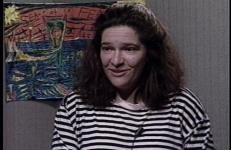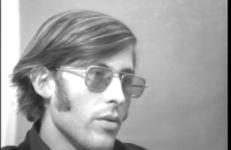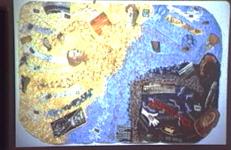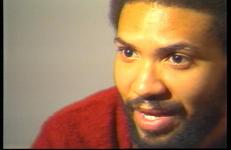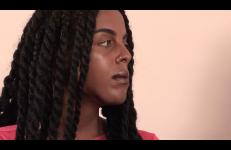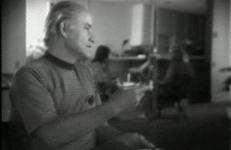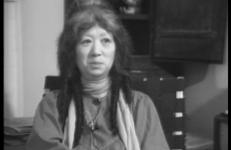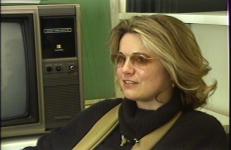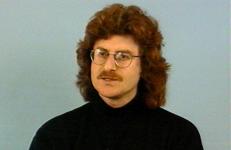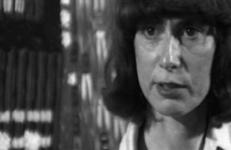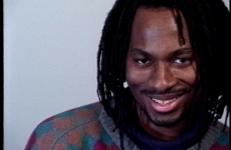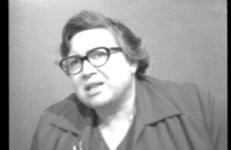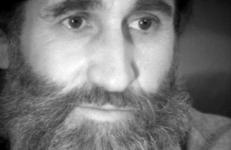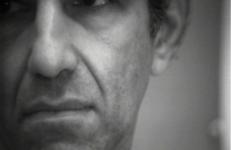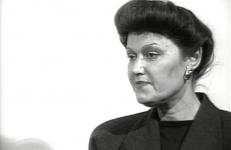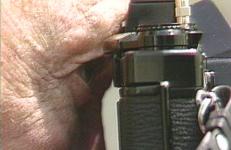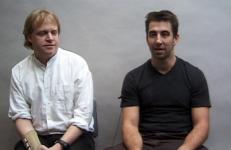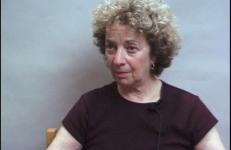Elizabeth Hess addresses issues of censorship, AIDS, war, feminism, and politics in general. She has written extensively on women’s issues, contributes to The Village Voice, and is co-author of Re-Making Love: The Feminization of Sex (1986). Interview by Lucy Lippard.
Interview
Hokey Sapp Does SPEW features Kate Schechter performing her invented media personality Hokey Sapp interviewing some of the luminaries at SPEW: The Homographic Convergence, a queer zine convention hosted by Randolph Street Gallery in Chicago in May, 1991. SPEW brought together artists, writers, editors of zines, performers, video-makers, activists, and bands from throughout the US and Canada, and marked the explosion of queercore subcultures through unabashed fashion, outrageous politics, humor, and joy.
Douglas Hollis (b.1948) was born in Ann Arbor, Michigan and continued to live there throughout the years of his college education at the University of Michigan. From an early age he had a deep interest in Native American culture. His experiences traveling in Oklahoma to live with Indian families has strongly influenced his life and his art ever since. Hollis began working with natural phenomena and responsive environment structures in the later part of the 1960's. At that time he completed several projects with musicians, dancers, film makers, engineers, and physicists.
In this interview with Carl Bogner, Sky Hopinka (b. 1984) discusses his process of becoming a video artist and his personal approach to documenting Indigenous landscapes and cultures. Hopinka is a member of the Ho-Chunk Nation of Wisconsin, and he is also an educator in Chinuk Wawa, a language indigenous to the Lower Columbia River Basin. Hopinka’s practice involves experiments within the cinematic language of documentary.
Taped shortly after the creation of the Air Gallery, this conversation between painter Howardena Pindell and Hermine Freed concerns the women’s independent gallery and its role in the feminist movement. Pindell also discusses the development of her work and the relation between black artists and the art world.
Documentarian and independent film producer Warrington Hudlin co-founded the Black Filmmaker Foundation in the late-1970s to help develop and promote emerging artists. More recently, he has been involved in DV Republic, a web-based alternative media site that is “socially concerned, entertainment driven,” and the screening series World Cinema Showcase, hosted by the American Museum of the Moving Image.
Interview by Shelley Shepard.
A historical interview originally recorded in 1983.
Juliana Huxtable was born in Texas and studied at Bard College, NY. An artist working across video, photography, poetry, and music, her practice demands a reexamination of the canon of art history in order to break the cycle of misrepresentation and under-representation in the contemporary art world.
Robert Irwin (b. 1928, Long Beach, California) followed in the Abstract Expressionist tradition until he shifted his focus onto installation projects that play upon site-specific uses of light. Since the 1980s, he has created large-scale public space designs that use natural light, plants, and garden architecture.
Miyoko Ito was known as an “abstract surrealist.” Her paintings are landscape-based abstractions of very intense subtleties of structure and color. Ito was born to Japanese parents in Berkeley, CA in 1918. She studied art at the University of California at Berkeley for a short time until she was imprisoned in a Japanese-American camp after the bombing of Pearl Harbor. Ito continued her education in prison, after which she attended Smith College. She was then given a scholarship to attend the School of the Art Institute of Chicago. It was in Chicago that Ito's career as an artist flourished, where she explored cubism and latent abstraction in her works. Ito remained in Chicago until her death in 1983.
The 1970s witnessed unprecedented artistic development of non-traditional media – chief among them were textiles and fabrics. Diane Itter was at the forefront of this boom in craft-oriented art making, designing colorful, geometric and exceedingly intricate fiber works that demanded near countless hours of time to execute. In this interview she discusses her practice, as well as the pitfalls that are encountered while working in what was – at the time of the interview – a still largely marginalized art form.
Alfredo Jaar is a politically motivated artist whose work includes installation, photography and film. Born in Chile and now living in the U.S., Jaar’s socio-critical installations explore global political issues, frequently focusing on the Third World and the relationship between consumption and power. A 1988 installation in a subway station in New York involved dramatic photographs of impoverished gold miners n Brazil interspersed with quotations of current gold prices, drawing an unexpected parallel between the material desires that motivate people in both poverty-stricken Br
Yvonne Jacquette (b.1934)is an American painter and printmaker known in particular for her depictions of aerial landscapes, especially her low-altitude and oblique aerial views of cities or towns, often painted using a distinctive, pointillistic technique. In addition to her paintings, Jacquette frequently collaborated with her late husband, the photographer and filmmaker Rudy Burckhardt, who was also known for his depictions of the urban environment.
In this 1993 contribution to the On Art and Artists series, artist Art Jones describes his entry into the world of activist media, and the genesis of his belief in the potential for a democratized street-level media. Hailing from the Bronx, Jones recalls his personal dislocation during college, when he began studying film and video at SUNY Purchase. At that time, Jones experienced a cultural isolation, which he mobilized to fuel his practice. This willingness to confront issues of representation and absence, asserting the validity of his own subjecthood, would become a defining characteristic of his work.
Miranda July (b.1974) makes performances, movies, and recordings—often in combination. Her videos (The Amateurist, Nest of Tens, Getting Stronger Every Day) present complicated parallel narratives with characters who experience loneliness, exploitation, unexpected phobias, and often inexplicable relationships. July has also recorded several performance albums released by Kill Rock Stars and K Records. In 1995 she founded Joanie 4 Jackie, an on-going movie distribution network for independent women movie makers.
Estelle Jussim (1928-2004) was regarded as one of the most influential voices in photography and media. An art historian and a communications theorist, Jussim wrote extensively about photographers, movements, and institutions, incorporating postmodern, deconstructionist, and feminist viewpoints in her many writings without being hemmed in by any one critical ideology. Jussim was the award-winning author of Slave to Beauty and the pioneering Visual Communication and the Graphic Arts, which charted new ground in the investigation of the meaning of images.
Tom Kalin is a screenwriter, film director, producer, and educator. As a key figure in New Queer Cinema, his work focuses on the portrayal of gay sexuality both in the age of AIDS and historically. Informed by his work with two AIDS activist collectives, ACT UP and Gran Fury, Kalin’s video work is characterized by appropriated images, original portraits, and performances.
In 1958, Allan Kaprow (1927-2006) published an article on Abstract Expressionism entitled The Legacy of Jackson Pollock in which he suggested the separation of the art-making activity from the art itself. Kaprow’s concept was most famously realized through Happenings, during which the traditional role of artist-creator was replaced by what he called “the social occasion.” In these events, divisions between artist and audience—and between the artwork and the perception of it—were dissolved.
American figurative artist Alex Katz (b.1927) has produced a remarkable and impressive body of work but is best known for his large-scale, flat, yet realistic portraits of friends and family notable for their relaxed attitudes and uncomplicated bearing. In the early 1960s, influenced by films, television, and billboard advertising, Katz began painting large-scale paintings, often with dramatically cropped faces.Utilizing characteristically wide brushstrokes, large swathes of color, and refined compositions, Katz created what art historian Robert Storr called "a new and distinctive type
Since the 1970s Mary Kelly (b.1941) has worked at the fore of feminist art and theory. She has continued to address issues and methods of activist politics, psychoanalysis, political science, literature, and the history of women and gender. Kelly received recognition in the early ’80s for her epic six-year project, The Post Partum Document, a mixed-media work chronicling her and her son’s development. Kelly says her work revolves “around the recurring themes of body, money, history, and power” in this interview with Judith Russi Kirschner.
A pioneer of the small-format camera, Andre Kertesz’s photographic vision shaped the course of contemporary photojournalism. Self-taught and non-conformist, he began photographing in Hungary in 1912 and remained there until 1925, at which time he moved to Paris. In 1936 he moved to New York City, where he felt displaced and forgotten. It wasn’t until 1964 that he was “rediscovered” and began showing in London, Paris, and New York. This video was shot five weeks before Kertesz’s death in 1985 at the age of 91.
I arranged a visit to poet/novelist Kevin Killian’s South of Market apartment in San Francisco to shoot a portrait of him, and when I arrived he had a guest, poet Cedar Sigo. They had corresponded earlier, but were meeting for the first time, and Cedar agreed to participate in our video shoot. This is perhaps the least planned, most verité and documentary of the videos about writers so far. Our immediate plan was for Kevin to read one of Cedar’s poems and for Cedar to read one by Kevin.
The interstice of art and technology has proved to one of the most generative locations in contemporary transdisciplinarity. As media of all kinds become more electronically integrated and digitized across multiple platforms, current technologies approach a condition of complete imbrication with art practices, and vice versa. Ben Knapp and Andy Diaz Hope have been at the forefront of these techno-aesthetic interactions, and their career experience as hard-science engineers brings a level of practical competence to this interview that is truly enlightening.
In this interview, Phyllis Kornfeld, author of Cellblock Visions: Prison Art in America, describes her initial interest in working with prisoners in her native Oklahoma City, stemmed from an exploration of outsider artists. Detailing her first visit to a high security prison as a ‘mind blowing and breathtaking’ experience, Kornfeld discusses how she came to her realization that prisons are fertile environments for free form experimentation with the teaching process. She learned that through personalized art education, inmates could teach themselves to make positive contributions to society. - Kyle Riley
Joyce Kozloff was at the forefront of the 1970s pattern and decoration movement—a feminist effort to incorporate typically “feminine” and popular decorative arts into the fine arts. She has been involved with public art and murals for more than two decades. In this video, Kozloff prepares and installs her mural Around the World on the 44th Parallel, which features sections of maps from 12 cities around the world on the same latitude. The work was constructed at the Tile Guild in Los Angeles and installed at the library at Minnesota State University-Mankato.




